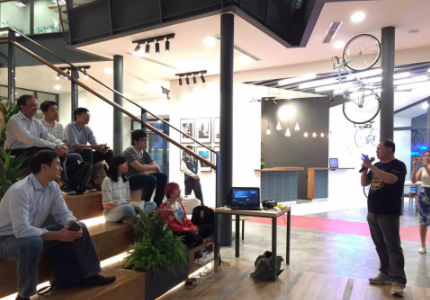In April, the VRARA Digital Health Committee conducted an industry survey. Our goal was to understand the current state of the VR/AR healthcare market and identify challenges to adopting VR/AR healthcare solutions.
In one question, we compiled a list of common hurdles to innovation and adoption of VR/AR healthcare solutions and asked respondents to rank them based on how significant each was to them, on a scale of 0 - 5 (five being “very significant”, zero being “not at all significant.”)
Our sample was small but we think reasonable conclusions can be drawn. Below are the median rankings for each of 12 challenges, in order of significance. (Note: while this first round was illuminating, we’re planning subsequent surveys to do a deeper dive into some of these key issues in the near future.)
Monetary/Funding Issues
(Significant Challenge: 4 out of 5)
Many of the respondents are startups developing AR/VR content, eyewear, or end-to-end solutions. So it’s not surprising that money and funding for product development, research and other marketing costs are at the top of the list. VR/AR for healthcare is still in its infancy, in search of technology innovators and visionaries willing to demo, refine and evangelize widely marketable applications. Given the obvious benefits of various emerging VR/AR technologies including pain diminution, surgical planning and practice, 3D radiological imaging and medical education, we’re confident that it won’t be long before customers and investors start to invest in best-in-class solutions.
Committee members have noticed that hospitals are increasing budgets for clinical simulation centers to allow them to purchase VR/AR equipment. Third party companies that work with medical organizations are starting to budget for VR/AR solutions as well.
Technical limitations; Organizational Issues; Lack of Knowledge / Research (Moderately Significant Challenges: 3 out of 5)
Technical limitations
This is a broad category and responses reflect a multitude of use cases. For some, the size of VR systems limits their use in certain clinical settings. For others, mobile VR platforms can only provide so much immersion with a pocket size computer. Computer specifications and resolution of available devices can also be limiting factors for some medical centers. VRARA Digital Health committee members are working on near-term solutions to these challenges. This is another area that we feel confident will improve over time as Moore’s law and market competition lead to improvements in both size and power.
Clinical organizational issues
You’ve probably heard that healthcare is a hard industry to change, and not lacking in bureaucracy. Electronic medical records, for example, have been in use at major hospitals for almost two decades, yet there are many places that still use paper charts.
Committee members and respondents identified several aspects of modern clinical organizations that can impede adoption of VR/AR technologies in healthcare, such as: availability of and access to infrastructure (i.e. bluetooth connectivity); platform friction (compatibility of VR/AR software with other healthcare software, EMR issues, and privacy issues); and procurement procedures (vendor relations, lengthy and complex public tender processes, and arduous hospital board decision making processes.)
AR solutions are likely to be adopted more quickly due to decreased platform friction of widely-adopted smartphone technologies. But it’s our guess that clinical organizational issues are likely to be some of the hardest (and slowest) issues to resolve.
Lack of knowledge
About VR/AR and its uses for your end users/customers
This is an area of particular interest for the VRARA committee. Many of our contacts and colleagues have heard of VR/AR being used for gaming and entertainment, but are unaware of the medical use cases and the research behind them. Disseminating this knowledge is an important goal of the committee. We know many people say they “get it” as soon as they demo VR/AR for the first time because it’s very intuitive, but most patients and providers have never had a live VR/AR experience. Understanding immersion is best done through one’s own eyes.
Lack of enough research studies around VR/AR in healthcare
A quick search of research studies shows over 3536 publications with “virtual reality” or “augmented reality” or “mixed reality” in the title since 1991. However, depending on the clinical use case there may only be a handful of useful studies. AR/MR tech is so new that only a small fraction of published research (574) examines its use in healthcare. Several areas still need randomized control trials to show evidence for mainstream adoption of AR/VR/MR by healthcare providers.
Regulation, Resistance, & Market Forces
Somewhat significant: 2 out of 5
Regulation/Insurance/Policy issues
Regulatory, insurance and policy issues always pose major hurdles for those working in healthcare. We’re speculating that they’re not more significant for responders right now because many times, regulation comes after wide-scale adoption. It’s on everyone’s minds, but we may not see a significant amount of red tape until VR/AR is more widely used in healthcare.
Resistance to new technology with end user/customers
The baby boomers still make up the largest percent of population by generation. Thus, they make up a large portion of both healthcare providers and patients. Nevertheless, reluctance to try new tech doesn’t seem to be a major concern for most respondents. There could be several reasons why this is true: for one thing, the majority of companies that responded are not making products or content for a specific demographic so age isn’t relevant. Second, physicians are typically early adopters of both professional and consumer tech, and interest in this new technology is high.
Market Issues and Cultural Obstacles (cultural competency)
Several respondents cited geographic and cultural obstacles as they try to market products in multiple countries, and a few mentioned resistance from Pharma to tech-based therapeutics. While it wasn’t called out as a major challenge we think it’s still important to keep culture in mind, especially given the international make-up of both the medical and VR/AR innovation communities.
Lack of Interest, Concern About Side Effects
Minimal Challenge: 1 out of 5
Lack of interest in VR/AR amongst patients and healthcare staff is of little concern to providers for now. As Facebook, Google, Oculus, Samsung and Sony continue to aggressively market VR/AR experiences for consumers, more people will be exposed to it and interest will grow. That said, patient demand and pull-through will eventually have a powerful influence on administrative and clinical decision-makers.
Early VR studies (in the 2000’s) caused a minority of patients to report feeling nauseous when using immersive VR. Over time, improved graphics, frame rates and game design have fixed some of the problems that caused that particular side effect and it seems to be less of a problem today. Motion sickness may continue to be a problem for a shrinking percent of populations studied, but is not a significant issue for this group of respondents.









